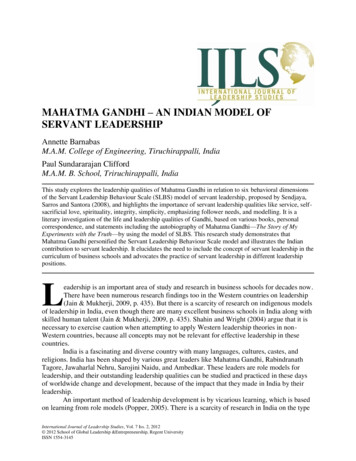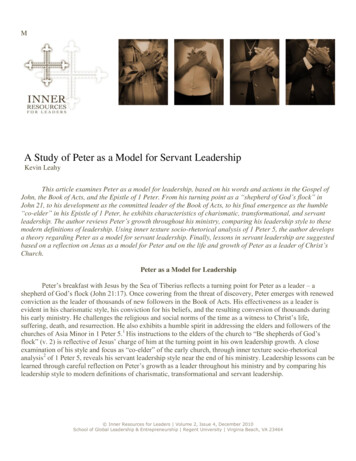
Transcription
Berrett–KoehlerPublishersBecoming a Servant Leader1 Becoming a Servant Leader
Table of ContentsI. Stop Putting Out Fires. Prevent Them from Starting.3II.What Does It Mean to Be a Servant Leader?.5III. Putting It into Practice: HelpingYour Organization Adopt Servant Leadership.10IV. Conclusion .192 Becoming a Servant Leader
I. Stop Putting Out Fires.Prevent Them from Starting.How do you spend your time at work? Doyou find yourself constantly caught betweenany number of urgent and important tasks,rushing from meeting to meeting and resolvingimmediate conflicts? If so, you probably havelittle time to pause for reflection, planning, orrelationship-building.The day-to-day duties of many professionals canbest be described as “putting out fires,” and allthat time spent firefighting can drain and exhaustus. It leaves precious little time for what’s reallyimportant: setting the right goals, ensuring theentire team or organization is aligned in workingtoward those goals, and fostering the ongoingprofessional growth in ourselves and othersneeded to achieve those goals.Need proof? Only about half of managersbelieve their organization’s strategic goals arereflected in how they spend their time.1 Somemanagers spend as little as 4 percent of theirtime coaching team members to help themreach personal and organizational goals.2No wonder it often feels like there aren’tenough hours in the day. Just maintaining thestatus quo can be a struggle. How can weshift our efforts away from putting out firesto preventing them from starting in the firstplace?We can start by examining our approach toleadership. Servant leadership addresses theroot causes of the time-and-energy-drainingchallenges of an organization that’s paralyzedby putting out fires. How? By recognizing thatrelationships within an organization are just asimportant as the results an organization is tryingto achieve. This simple shift in mindset canbring all members of an organization—from thefrontline employee to the CEO—into alignmentaround the same strategic goals, and empowereach and every individual to execute on thosegoals in their unique roles. At the same time,the emphasis on relationships elevates criticalfactors of organizational culture like employeeengagement, retention, and diversity andinclusion, resulting in not just a more effectiveorganization, but also a much more functionaland fulfilling place to work.1. anizations-priority2. ntline-managers3 Becoming a Servant Leader
A servant leadership approach achieves thisby turning traditional top-down leadershipon its head. Leaders are tasked with settinga visionary direction, establishing values toguide the path, and setting goals to serve asmile markers. Then, they get out of the way.Their roles shift to supporting the executionof the vision, serving team members who areexecuting the vision, and allowing them to beaccountable for their own success.In Becoming a Servant Leader, we’ll explorehow servant leadership can address the4 Becoming a Servant Leaderroot causes of some of organizations’ worstdysfunctions: employee disengagementand burnout, lack of collaboration, siloeddepartments, and toxic workplace cultures.Whatever your role in your organization—whether you are looking to implement anorganization-wide training intervention orculture shift, looking for a better way tomanage a team, or simply looking to improveyour relationships with your colleagues—this guide will serve as your roadmap toimplementing the tenets of servant leadershipin your organization.
II. What Does It Mean toBe a Servant Leader?Who is the best boss you’ve ever worked for?What set them apart?Your answer probably has to do with twothings: clear goals or direction, and yourpersonal relationship.Both are key to servant leadership, but that’sjust the beginning. According to the DaleCarnegie Institute, the top three behaviors orqualities employees value most in a boss are3:Encouragement and supportthat helps drive the employees’growth and developmentGiving praise andvaluable feedbackValuing theopinions of othersAll three behaviors are essential to a servantleader. Servant leaders make a personalinvestment in the people and communitiesaround them. They express genuine empathyand understanding. In doing so, they buildtrust and empower individuals around them toachieve their full potential.Servant leaders are also forward-looking.They’re able to bring big ideas to life in day-today operations by working with direct reportsto create a clear vision, develop clear andmeasurable goals, and then execute the vision.In short, great leadership isn’t about beingthe smartest person in the room. Greatleadership is about creating clear directionand empowering and supporting others in itsexecution.Being a CEO or top executive is not aprerequisite for servant leaders. In fact, servantleadership can flourish in individuals workingat all levels of an organization. A manager canbe a servant leader to her direct reports. Teammembers can act as servant leaders to theirpeers. Servant leadership can flourish withinsmall task forces, committees, departments,or divisions within a company. From there,servant leadership can spread outward andupward, igniting a company-wide commitmentto align around the same goals, empowerothers to reach their full potential, and build astronger community.3. 5 Becoming a Servant Leader
A. The Evolution of ServantLeadershipThough Robert K. Greenleaf pioneered theconcept of servant leadership more than 50years ago, servant leadership is more relevanttoday than ever before. Greenleaf wrotethat the servant leader focuses “primarilyon the growth and well-being of people andthe communities to which they belong.”Traditional pyramid-shaped, command-andcontrol leadership structures emphasize the“accumulation and exercise of power by oneat ‘the top of the pyramid.’” Many of the firesthat professionals spend their time puttingout are ignited by this power struggle. Servantleaders, however, share power and help thosearound them “develop and perform as highlyas possible,” Greenleaf writes.Why is servant leadership more relevant todaythan ever? The incoming workforce demandsit. Research shows that as millennials assumea larger and larger share of the U.S. workforce,they’re looking for organizations that “putpeople over profit,” “behave in an ethicalmanner,” and have “leaders committed tohelping improve society.4”Since its inception in the 1970s, servantleadership has continued to evolve. Leadershipexpert and bestselling author Ken Blanchard,one of today’s top authorities on servantleadership, explains that employees will servetheir own interests unless they’re given amore compelling purpose or vision to serve.He breaks down servant leadership into twofundamental steps in Servant Leadership inAction, a collection of essays that Blanchardedited with Renee Broadwell: Visionary/Direction: The leadershipcomponent of servant leadership,visionary/direction requires leaders to giveteam members a compelling vision of thefuture, overarching values to guide theirway, and strategic goals to strive for. Implementation/Operational: Theservice component of servant leadership,implementation/operational requiresservant leaders to flip the traditionalhierarchical pyramid. This makes teammembers responsible for achieving goalsand objectives, and the servant leaderresponsive to the team members’ needs.In traditional command-and-controlhierarchies, the opposite is true.“Servant leaders are alsoforward-looking. They’reable to bring big ideas to lifein day-to-day operations byworking with direct reports tocreate a clear vision, developclear and measurable goals,and then execute the vision.”4. loitte/articles/millennialsurvey.html6 Becoming a Servant Leader
In the bestselling book, Servant Leadershipin Action, Blanchard notes a commonmisunderstanding that servant leadershipallows employees to decide “what to do,when to do it, where to do it, and how to doit.” Of course, that’s false. The first step is toestablish vision, values, and goals.“Once people are clear on where they aregoing, the leader’s role shifts to a servicemindset for the task of implementation—the second aspect of servant leadership,”Blanchard writes. “The question now is:How do we live according to the visionand accomplish the established goals?Implementation is where the servant aspect ofservant leadership comes into play.”“Focusing your energy onpeople and relationshipscan actually improve yourorganization’s profits.”7 Becoming a Servant LeaderB. The Characteristicsof a Servant LeaderServant leadership expert Larry C. Spearswrites in Servant Leadership in Action that“servant leadership characteristics oftenoccur naturally within many individuals and,like many natural tendencies, they can beenhanced through learning and practice.” Butwhat, exactly, are those characteristics? Spearsidentifies the 10 most common characteristics: Listening Empathy Healing Awareness Persuasion Conceptualization Foresight Stewardship Commitment to others’ growth Community building
Unfortunately, many organizations are not set up to inspire or encourage these characteristics intheir leaders. Raj Sisodia, a leader of the global-conscious capitalism movement, explains thatthis has made work a source of “deep suffering” for many people today. “Leaders are productsof the systems that give rise to them. The existing system has elevated people into positions ofleadership who lack the qualities needed to lead in today’s world. These people do whateverit takes to deliver the numbers without regard to human cost or long-term consequences fororganizational health,” Sisodia writes in Servant Leadership in Action. This mindset is yetanother source of ignition for the many fires that professionals are constantly working to put out.Why do so many leaders choose the “whatever it takes” philosophy over servant leadership?Because that’s what they’ve learned, and they’ve been rewarded for it. However, focusing yourenergy on people and relationships can actually improve your organization’s profits. “In thelong run, our research shows that such companies generate far more financial wealth than dotraditional profit-centered firms—outperforming the S&P 500 index by 14 to 1,” Sisodia writes.How is that possible? Because employees are more engaged and productive when they’reworking for a higher purpose. Servant leadership offers just that.8 Becoming a Servant Leader
C. The Inclusive, “For All” Culture ofServant LeadershipThere’s good news and bad news whenit comes to diversity and inclusion. Thegood news is that there’s widespreadacknowledgment that businesses benefit fromdiverse teams and inclusive environments.Research shows that teams that includeindividuals from a wide range of ages andbackgrounds make better decisions 87 percentof the time.5 The bad news, however, is thatcompanies spend up to 8 billion per year ondiversity and inclusion training programs—andsee few results in return.6 In fact, diversity andinclusion training can actually do more harmthan good, resulting in what economists call“diversity fatigue.” Maybe the solution isn’tmore diversity training. Maybe the solutionis a new approach to leadership that putsrelationships first.Servant leadership can help by fostering “forall” workplaces. In A Great Place to Work forAll, Michael C. Bush, the CEO of Great Placeto Work, the organization behind Fortunemagazine’s 100 Greatest Places to Work,notes “significant gaps in the employeeexperience between groups of people.” Gapscan arise from gender, race, sexual orientation,disability status, religious beliefs, or thedifferent background of experiences we allbring to the workplace. “These gaps meannot everyone is having a positive experience,which means they are not likely to bringthe best of what they have to offer to theorganization.”Servant leadership can help reduce these gapsby introducing “mediating mechanisms” intothe workplace that help manage relationshipsand create a climate of inclusion.7 Becauseof their focus on service to the entire teamor organization, servant leaders work toensure that all employees are heard. Theysee it as their responsibility to act as healing,empathetic forces when cultural differencesemerge. Servant leaders also foster a culture ofcollaboration that allows individual membersto best use their unique skills and talents—while learning new skills from their peers. The“for all” nature of the servant leadership modelalso creates opportunities for all employeesto advance professionally and reach their fullpotential. There is, of course, a great deal ofwork to be done in fostering more inclusiveworkplaces and change won’t occur overnight,but encouraging your organization’s leaders toadopt a servant leadership approach can be agood start.“Find a way to get thatspotlight to shine on others.”Cheryl Bachelder, Dare to Serve5. making-at-work/#a1125754cbfa6. tes-men-fails-women/7. https://www.researchgate.net/publication/303997416 The role of servant leadership in fostering inclusive organizations9 Becoming a Servant Leader
III. Putting It into Practice: Helping YourOrganization Adopt Servant LeadershipYou might be thinking that servant leadership sounds nice in theory, but is really a utopian pipedream. On the contrary, servant leadership is actually extremely practical. In this section, we’llexplore some steps you can take to begin practicing servant leadership at your own organization.We’ll discuss the ins and outs of applying servant leadership to any level of the organizationby setting a clear vision and building supportive, open relationships, as well applying servantleadership on a larger scale to drive overall vision, strategy, organizational cultural shifts, andeven things like talent management and hiring policy.A. Create a Compelling—and Relatable—Vision of the Future“I love the saying ‘a river without banks is a large puddle.’The banks permit the river to flow; they give direction tothe river. Leadership is about going somewhere; it’s notabout wandering around aimlessly. If people don’t have acompelling vision to serve, the only thing they have to serveis their own self-interest.”- Ken Blanchard, Servant Leadership in Action.When organizational leaders are able to clearly communicate their strategic vision, they can expectbetter results and higher profits.8 Yet, in one survey, just 33 percent of executives were confident thattheir employees could articulate their company’s strategic direction.9 Clearly, many organizationalleaders struggle to clearly define and communicate a vision and clear goals for their team.Here’s where the visionary part of servant leadership comes into play. Remember, employees willserve their own interests unless they’re given a clear organizational vision to contribute to. It’s the8. oyees-to-help-achieve-your-strategic-vision/9. ngaged-300096754.html10 Becoming a Servant Leader
leader’s job to provide that vision—and to communicate it effectively, make sure it’s simple andrelatable, and set clear values and goals.1. Create a Simple Vision3. Incorporate Clear Values and GoalsKen Blanchard warns that many leaders makepurpose statements too complex. In ServantLeadership in Action, he uses Walt Disney’spurpose statement, “We’re in the happinessbusiness,” as an example of a clear, simplepurpose that tells employees of Disney themeparks that their job isn’t to run an amusementpark—it’s to make visitors happy.As part of your vision, you’ll need tocommunicate values and goals.2. Make It RelatableIn their book, Full Steam Ahead!, KenBlanchard and Jesse Lyn Stoner write thatrelatability “makes vision accessible toeveryone, in both their organizations and theirpersonal lives.”The key is to not only create a compellingvision, but to create a shared vision. Thatmeans all team members must clearlyunderstand the vision and relate to it. Mostimportantly, they also have to see how they’redirectly contributing to it. It should be possibleto apply the vision to the day-to-day work ofteams, committees, departments, divisions,and even individual contributors. This makesthe vision more relatable because employeesare directly in control of—and accountablefor—its success or failure.11 Becoming a Servant LeaderKen Blanchard writes in Servant Leadership inAction, “Values provide guidelines for how youshould proceed as you pursue your purposeand picture of the future. They answer thequestions, ‘What do I want to live by?’ and‘How?’ They need to be clearly describedso that you know exactly what behaviorsdemonstrate those values as being lived.”Like values, goals need to be clearly definedand measurable. They should be agreed uponby leaders and team members so that teammembers understand exactly what they’reresponsible for, what success looks like, andhow to get there.“The key is to not only create acompelling vision, but to createa shared vision. That meansall team members must clearlyunderstand the vision andrelate to it.”
B. Building Personal Relationships in the Professional WorkplaceStrong personal relationships are key to the service aspect of servant leadership. Once the leaderestablishes the vision, their role shifts to empowering team members to execute the vision. Thismeans working with team members to ensure they have the support, resources, developmentopportunities, feedback, and whatever else they need—which requires open and honestrelationships between leaders and team members. Team members and leaders alike must becomfortable expressing their needs and limitations. Indeed, leaders who are honest about theirown limitations, show respect and appreciation, and give credit where deserved have beenfound to foster more creative, innovative, cohesive teams.10Dare to Serve author Cheryl Bachelder’s experience being honest about herlimitations as a leader shortly after taking over as CEO of Popeyes helpedbuild a stronger team. During a meeting of vice presidents and directors,each participant wrote down the first thing they’d fix about the companyon a Post-it note. Bachelder recalls that a participant who’d been withthe company for over a decade sighed and said that everyone wrotedown the same things every year, and nothing changed. “I was initiallyshocked, but I appreciated her candor. It was a reminder of the energywasted in corporate America while people focus on work that isn’t producingresults. Even CEOs shy away from hard things—worry about gettingthe board aligned, or finding the money for a project,” Bachelderwrote in the Harvard Business Review. In response, Bacheldertold that participant that “we wanted to be the group that finallyfixes problems—not all of them, but the few on which wecould focus to make the most impact.” By admitting to herown limitations, Bachelder strengthened the group’s focus.Bachelder’s exchange demonstrates a highly personalizedleader-follower relationship. Although hard to hear,Bachelder appreciated and took the participant’s candor toheart. Impersonal leader-follower relationships, on the otherhand, accomplish the opposite.10. http://psycnet.apa.org/record/2017-49118-00112 Becoming a Servant Leader
Edgar H. Schein, an expert on organizational development and behavior whose career spanshalf a century, and management consultant Peter A. Schein expand on this point in their book,Humble Leadership. Based on traditional command-and-control organizational hierarchies,impersonal leader-follower relationships can lead to high turnover, disengaged talent, and safetyand quality problems. “We therefore need a model of leadership that is more personal andcooperative, that changes relationships both inside organizations and between organizationmembers and their customers, clients, and patients,” they write.Here are three ways to build more open andauthentic personal relationships:1. The Virtue of HumilityIn his bestselling book, Humble Inquiry, EdgarH. Schein makes an important statement:Leaders depend upon team members. Whenleaders reflect that in how they communicatewith employees, they open the “door tobuilding a relationship.” Schein calls thisbehavior “humble inquiry.” Leaders whoask rather than tell team members to dothings, Schein writes, imply that “the otherperson knows something that I need to orwant to know. It draws the other personinto a situation and into the driver’s seat; itenables the other person to help or hurt meand, thereby, opens the door to building arelationship.” This communication techniquecan play a critical role in fostering the openrelationships required for servant leadership tothrive.2. A Little Love Goes a Long Way“Love” isn’t a word that generally comes up in13 Becoming a Servant Leaderleadership training, but maybe it should.Raj Sisodia writes in Servant Leadershipin Action that the opposite of love is fear.“An organization suffused with fear isinherently incapable of genuine creativity andinnovation,” he writes. Sisodia notes thathistory’s greatest leaders—Lincoln, Gandhi,Mandela, King—all “possessed tremendousstrength along with a powerful capacity forcaring. They were able to expand their circleof caring to encompass more and more ofhumanity—often including their own so-calledenemies.” They cared truly and deeply aboutothers and demonstrated why “a fundamentalleadership quality is the ability to operatefrom love and care.” When it comes toadopting servant leadership, love is a requiredingredient.Showing that you care about a team memberor direct report can be as simple as askingthem how they are and listening to what theysay. Making sure you give time and space forthis is a simple but powerful way to showyou care—and a building block for the type ofrelationships servant leadership thrives on.
3. Treat Your People RightIt may sound simple, but treating employees with respect goes a long way. Colleen Barrett, thepresident emerita of Southwest Airlines, notes that one of the company’s leading priorities is tobe “the employer of choice.” That’s reflected in the company’s philosophy on leadership: Treatyour people right, and good things will happen. That means treating employees with “GoldenRule behavior” and making sure the work environment is enjoyable, and people feel good aboutwhat they do, about themselves, and about their position in the company.“Not only do we serve and care about our people, but we empower them to use common senseand good judgment. Yes, we have written rules and procedures, and you can go look at them, butwe say to our folks every day, ‘The rules are guidelines.’” This means employees can go off scriptwhen the situation warrants it without fear of punishment or retaliation. In trusting employees touse their own judgment, instead of written rules and procedures, to make the correct decisions,Southwest leadership demonstrates respect and empowers their employees to bring their fullselves to work. In return, Southwest employees can trust their leaders to do the same.14 Becoming a Servant Leader
C. Taking the First Steps to Implementing Servant LeadershipAnyone, regardless of their place in the organizational hierarchy, can choose to set a clear visionfor themselves or their team and invest in relationships. But how can servant leadership beimplemented on an organizational level? Here are some ideas.Adopting Servant Leadership Organization-Wide1.Educational Programs: Books or training curriculum on servant leadership are a greatway to introduce your organization to the key points of servant leadership.2.Organizational Analysis: Conducting an organizational analysis will allow you to identifygaps in current leadership strategies and mentalities. It will also provide baseline data togauge the effectiveness of servant leadership after implementation.3.Coaching: Coaching sessions can help accelerate learning and foster the culture and senseof community that are critical for servant leadership to thrive.4.Evaluation: Set a timeline for servant leadership implementation, and establish anevaluation timeline for check-ins with various leaders and departments at differentmilestones.5.Continuing Education: Ongoing servant leadership training with guest speakers, trainingsessions, certifications, and other continuing education programs are critical to effectiveimplementation. Here are a couple of recommendations: The Robert K. Greenleaf Center for Servant Leadership offersworkshops such as Implementing Servant Leadership. The Ken Blanchard Companies offers many training programs that incorporateelements of servant leadership. 15The Newton Institute offers a full slate of leadership training courses and workshops. Becoming a Servant Leader
Implementation of servant leadership requiresshifting to a mindset that equally valuesrelationships and results, prioritizes empathy,focuses on asking instead of telling, andcommits leaders to supporting their teams.The most successful implementation strategyfor servant leadership combines educationalcurriculum, collaboration among stakeholders,and continuing education.Remember, servant leadership doesn’t haveto trickle down from the top. In fact, thebest implementation strategies for servantleadership begin with a small team, task force,or division that can successfully foster a senseof community.D. Servant Leadership froman HR Perspective1. Recruit for Character, Not SkillsIf your organization sources talent with specificskills and certifications, it might be approachingrecruitment all wrong. If you want to create16 Becoming a Servant Leaderand sustain an organizational culture orientedaround servant leadership, your first questionshould be, “Does the candidate fit our values?”Remember, most people have the potential tolearn new skills. Fewer people have the serviceminded character you might be looking for. Inthe Servant Leadership Online Training Summit,a 2017 event co-produced by Ken Blanchard,Berrett-Koehler Publishers, and ConsciousMarketer, the leaders of Waste Connections putit this way: “You can’t train character.”2. “I Am Here to Serve”: Serving from anHR PerspectiveShirley Bullard, The Ken BlanchardCompanies’ Chief Administrative Officer, notesthat the service aspect of servant leadershipcan be an exceptional guiding principle forthe unpredictable and unscripted encountersof the HR professional. In Servant Leadershipin Action, she writes, “There is no clear-cutplan of what to do or not to do. But with amindset of ‘I am here to serve,’ you can get
through even the most challenging eventwith grace. Notice I did not say ‘withoutangst, second guessing, or fear.’ These arereal emotions that exist for any leader whofinds themselves encountering a situation thatis unfamiliar territory.” It’s no coincidencethat the strengths of top HR leaders reflectcharacteristics of servant leaders. A review ofglobal data on thousands of HR leaders foundthat developing and coaching others, buildinginclusive relationships, positive relationshipsthat foster diversity and inclusion, “walkingthe walk” by honoring commitments andpromises, and having technical expertise andknow-how are characteristics of top-rated HRprofessionals. What do those characteristicshave in common? Service to others.work, and treating others with respect.12You can imagine that an organization whoseculture displays these types of qualities tendsto invest heavily in relationships. Organizationsthat don’t invest in relationships suffer theconsequences.How do you go about changing a dysfunctionalculture? The solution is usually not found incompany trainings or social events like freebeer Fridays or company outings. After all, adysfunctional culture is often the symptomof a core issue, not its root cause. The rootcause can often be traced to the organization’sapproach to leadership and a values systemthat prioritizes profits over people. Adopting aservant leadership approach can be a powerfuldriver of positive culture change.E. Leveraging Servant Leadership toLead Positive Culture ChangeHow important is company culture tosuccess? One survey found that 84 percentof employees ranked company culture as thetop indicator of success—but 51 percent ofrespondents said their company’s cultureneeded a “major culture overhaul.”11Harvard researchers have identified thefollowing qualities of positive workplacecultures: caring for and being interested inothers, providing support and offering kindnessto the struggling, avoiding blame and forgivingmistakes, emphasizing meaningfulness of“Leaders are productsof the systems that giverise to them. The existingsystem has elevated peopleinto positions of leadershipwho lack the qualities neededto lead in today’s world.”Raj Sisodia, Servant Leadership in Action11. -success12. ultures-are-more-productive17 Becoming a Servant Leader
Shining the Spotlight on Others: How One Servant Leader Drove ChangeFormer CEO of Popeyes Louisiana Kitchen, Cheryl Bachelder inherited a broken franchise whenshe assumed control of the company in November 2007. The
7 Becoming a Servant Leader In the bestselling book, Servant Leadership in Action, Blanchard notes a common misunderstanding that servant leadership allows employees to decide “what to do, when to do it, where to do it, and how










